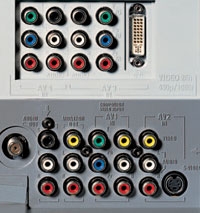Philips 34PW9819 34-inch HDTV Monitor Page 2
Check the rear panel, and you'll find it's very up to date in the connectivity department. In addition to a copy-protected DVI (Digital Visual Interface) input, there are two sets of high-def component-video jacks that accept 1080i (interlaced) and 480p (progressive-scan) signals. A third component input is meant for connecting a standard (480i) DVD player. The Philips doesn't have a built-in digital tuner, so its single antenna input is compatible only with analog off-air or cable signals.
 The TV's slender, well-built remote control looks cool and feels pretty good, too. Its keypad isn't backlit, and the icon-based labeling system sometimes had me scratching my head and reaching for the manual, but I eventually learned to appreciate its clean, minimalist design.
The TV's slender, well-built remote control looks cool and feels pretty good, too. Its keypad isn't backlit, and the icon-based labeling system sometimes had me scratching my head and reaching for the manual, but I eventually learned to appreciate its clean, minimalist design.
Switching the set's inputs is a two-step process that entails either repeatedly pressing the Input button until you reach the one you want or pressing it once and scrolling through a list of onscreen options with the remote's arrow keys. Similarly, you can choose from a variety of display options, including 4:3 and 16:9 plus a bunch of zoom and stretch modes, by pressing the Picture Format button - but only with standard TV or DVD programs (480i). So make sure that any progressive-scan DVD player you use provides its own display-mode (aspect ratio) controls.
Another function that's limited to standard signals is the picture-in-picture (PIP) feature, which Philips calls Dual Screen because it lets you view two video sources side by side. You can select between a small, medium, or large inset window for the secondary image. The TV also has an image-freeze function - useful for grabbing and writing down those psychic hotline numbers shown on late-night TV.
The Philips doesn't let you store custom picture adjustments for each of its video inputs, but I was able to create two Personal picture memories for my custom adjustments - one for 480i and the second for 480p/1080i signals. Still, I'd have preferred more customizable options, especially since I used both the DVI and component-video jacks to connect high-def sources. 
You can turn Philips's proprietary Pixel Plus processing on or off when watching standard-def programs on DVD or TV. I found that it enhanced otherwise cruddy-looking programs on satellite or cable, but it lent an odd "pebbled" texture to images from high-quality sources like DVD movies. It also seemed to slightly speed up the action, giving the movies a "home video" look I found disconcerting.
After making some service-menu adjustments to the Philips (see "in the lab" at the end of this article), I tossed the new remake of The Texas Chainsaw Massacre into my progressive-scan DVD player. I was immediately impressed with how clean and detailed the picture looked. In a wide shot of a van carrying the soon-to-be-lunchmeat teens careening across a lonely Texas highway, I could see the microscopically thin power lines hanging in the distance.
- Log in or register to post comments




















































